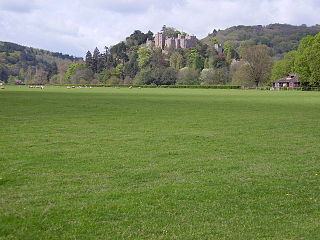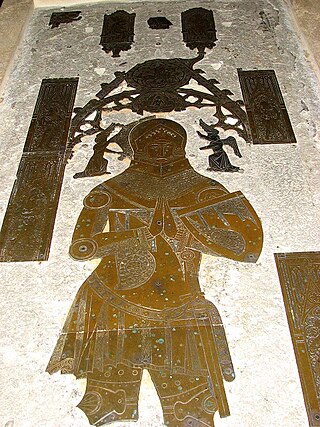
The Battle of Crécy took place on 26 August 1346 in northern France between a French army commanded by King Philip VI and an English army led by King Edward III. The French attacked the English while they were traversing northern France during the Hundred Years' War, resulting in an English victory and heavy loss of life among the French.

Thomas Holland, 2nd Baron Holand, and jure uxoris1st Earl of Kent, KG was an English nobleman and military commander during the Hundred Years' War. By the time of the Crécy campaign, he had apparently lost one of his eyes.

Thomas de Beauchamp, 11th Earl of Warwick, KG, sometimes styled as Lord Warwick, was an English nobleman and military commander during the Hundred Years' War. His reputation as a military leader was so formidable that he was nicknamed 'the devil Warwick' by the French. In 1348 he became one of the founders and the third Knight of the Order of the Garter.

Sir James Audley, KG was one of the original knights, or founders, of the Order of the Garter. He was the eldest son of Sir James Audley of Audley in Staffordshire.

Heraldic visitations were tours of inspection undertaken by Kings of Arms throughout England, Wales and Ireland. Their purpose was to register and regulate the coats of arms of nobility, gentry and boroughs, and to record pedigrees. They took place from 1530 to 1688, and their records provide important source material for historians and genealogists.

Cruwys Morchard is an ecclesiastical and civil parish in the Mid Devon district of the county of Devon in England. It is located about four to five miles west of Tiverton along the road to Witheridge. The parish covers about 5,765 acres (23.33 km2) of land, and comprises a number of scattered houses and farms, and three small hamlets, Pennymoor, Way Village and Nomansland. The church and the manor house are in the centre of the parish. The population at the time of the 2000 census was 461. The parish takes its name from the Cruwys family who have been Lords of the Manor here since the reign of King John (1199–1216).

Sir Hugh de Courtenay, 2nd/10th Earl of Devon, 2nd Baron Courtenay, feudal baron of Okehampton and feudal baron of Plympton, played an important role in the Hundred Years War in the service of King Edward III. His chief seats were Tiverton Castle and Okehampton Castle in Devon. The ordinal number given to the early Courtenay Earls of Devon depends on whether the earldom is deemed a new creation by the letters patent granted 22 February 1334/5 or whether it is deemed a restitution of the old dignity of the de Redvers family. Authorities differ in their opinions, and thus alternative ordinal numbers exist, given here.

Robert Ufford, 1st Earl of Suffolk, KG was an English peer. He was created Earl of Suffolk in 1337.

Sir John Dawney or Dawnay (d.1346/7) was the eldest son of Nicholas Dawney of Mudford Terry, Somerset, and his wife, Elizabeth.

Robert Cooke was an English Officer of Arms during the reign of Elizabeth I, who rose swiftly through the ranks of the College of Arms to Clarenceux King of Arms, serving in that office from 1567 until his death in 1592–3.

Sir Hugh Paulet of Hinton St George in Somerset, was an English military commander and Governor of Jersey.

Sir Simon Every, 1st Baronet (1603–1647) was an English politician who sat in the House of Commons in 1640. He was a supporter of the Royalist cause in the English Civil War, and the first of the Every Baronets.
John Devereux of Manne was a member of a prominent knightly family in Herefordshire during the reigns of Edward II, and Edward III. He fought at the Battle of Crecy, and gave rise to the Devereux Barons of Whitchurch Maund.

The feudal barony of Dunster was an English feudal barony with its caput at Dunster Castle in Somerset. During the reign of King Henry I (1100–1135) the barony comprised forty knight's fees and was later enlarged. In about 1150 the manors retained in demesne were Dunster, Minehead, Cutcombe, Kilton and Carhampton in Somerset, and Ham in Dorset.

The Worthingtons are a historic English family from Lancashire, traceable to the beginning of the 13th century. The progenitor of the line was Worthington de Worthington, and the family were Lords of the Manor of Worthington, Standish, Lancashire from the 13th to the 18th centuries. The family seat was Worthington Hall, Standish, County Lancashire; partially demolished in the mid-20th century, the remaining Tudor doorway dated 1577 Edward de Worthington.

The Everys are an historic English family from the West Country, traceable to the late 12th century and maternal cousins to the Brice family. They were significant landowners in Devon, particularly in Chardstock and Shepton Beauchamp, and as Lords of the manor of Wootton Abbotts. The family seats were Wycroft Castle, Wootton Abbotts manor house, and Egginton Hall. On 26 May 1641 a branch of the family developed into the Every baronets, and the late 17th-century English pirate Henry Every is believed to have descended from an earlier line.

Sir Thomas Courtenay of Wootton Courtenay in Somerset, was a knight and an English military commander against the French during the Hundred Years' War, who died about six years after the Battle of Poitiers.
Sir Willian Felton and English knight and seneschal of Poitou. Took part in Battle of Halidon Hill, 1333 and fought at Crecy in 1346. He was appointed lord justice of all the king's lands in Scotland in 1348. He fought at battle of Poitiers in 1356. He was appointed seneschal of Poitou in 1360. He accompanied the Black Prince on the Spanish campaign in 1367 and was called Felleton Guilliam qui ot cœur de lyon by Chandos Herald. He was killed at the battle of Aríñez a skirmish fought by the vanguard of the Black Prince's army.

Sir Hugh Hastings I (c.1310–1347) was an English administrator and soldier. He fought for Edward III in the first phases of the Second War of Scottish Independence and the Hundred Years' War. His largely surviving monumental brass in Elsing Church in Norfolk is "one of the most celebrated of all English brasses".

John Strode, the son of Robert Strode of Parnham, Dorset and Elizabeth Hody, was elected MP for Dorset in 1572 and was Sheriff of Dorset from 1572 to 1573.





















